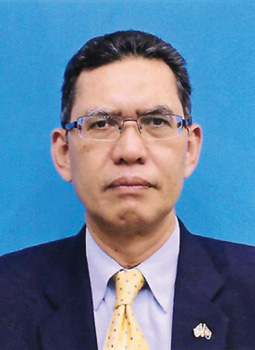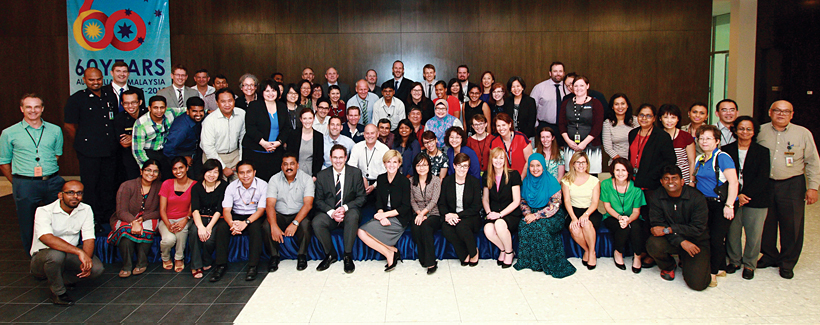Conclusion
This 60th anniversary year gives us a moment to reflect on our past achievements and look forward to our future collaborations. It is an opportunity to take stock of the depth and breadth of the relationship, and how it has grown as our dynamic region has evolved.
In 1955, Malaya was not yet independent; the concept of Malaysia not yet formed. A communist insurgency was troubling the region. Trade between our two countries was modest, focused on commodities. A few hundred young Malayans had studied in Australia.
Building on the shared ordeal of the war in the Pacific, the foundations for the relationship we have today were laid in our first decade of formal relations. Both countries had a vision, not only for what the security and economic relationship might deliver, but how we might best cement our friendship and build cultural understanding. Opening reciprocal diplomatic missions in 1955 and 1956 was a recognition that we were each worth knowing, understanding and collaborating with. From that point, each country would play an important role in our future prosperity and strategic environment.
Early representatives like Dato' Gunn Lay Teik in Canberra and his counterpart Tom Critchley in Kuala Lumpur displayed an indefatigable enthusiasm for promoting the Australia–Malaysia relationship. These early days were also the beginning of a tradition of prime ministerial visits that were marked by an amicable rapport. In 1959, Prime Minister Tunku Abdul Rahman visited Australia, and Sir Robert Menzies visited Malaya. Every Australian prime minister since has visited Malaysia, and every Malaysian prime minister has reciprocated. Today, such visits continue to strengthen the relationship, enhance political engagement at the highest level and build common agendas.
Our long-standing security partnerships, which have evolved since World War II and reflect the bond established by the shared ordeal of the Malayan Campaign and Sandakan, sustain our ongoing engagement. This is evident in the resilience of the Five Power Defence Arrangements, which continue to foster close cooperation between Australia and Malaysia, and in the durable working relationship that was mobilised into action during the aftermath of the MH370 and MH17 tragedies in 2014. The network of security arrangements and cooperation on transnational crime between our two countries provides a solid foundation for meeting future contingencies in areas of ongoing risk, such as people smuggling and trafficking, health pandemics or challenges around terrorism and cyber security.
The expanding web of regional collaboration assists countries in the region to manage issues that have become increasingly complex in the twentyfirst century. ASEAN is at the centre of many such initiatives. Australia's recently elevated relationship with ASEAN – now a strategic partnership – recognises Australia's contribution to the region and a convergence of interests with Malaysia and others on a broad range of issues. Australia continues to make significant investments towards encouraging economic growth in ASEAN members as well as assisting the realisation of the ASEAN Economic Community (AEC). Australia and Malaysia are actively involved in many regional partnerships and forums, including the ASEAN Regional Forum (ARF) founded in 1994, the East Asia Summit (EAS) in 2005, the ASEAN Defence Ministers Meetings Plus (ADMM-Plus) in 2010, as well as the Asia-Pacific Economic Cooperation (APEC) launched in 1989. This firm commitment to regional diplomacy signifies a shared commitment to dialogue, peaceful resolution of disputes and economic liberalisation and integration.
Our trade and investment ties have also blossomed over time, building on promising foundations. Malaya was one of the seven places visited by Australia's first diplomatic trade mission to Asia in 1934 and one of the first Asian countries with which we formalised trade arrangements after World War II. In the years after Malaysia's independence bilateral trade intensified and has seen rapid growth in recent years. Some 3600 Australian companies now export to Malaysia each year and more than 200 Australian companies are represented in Malaysia. We rank among each other's top ten trading partners.
Education has long been a pillar of the bilateral relationship. From the 1950s, thousands of Malaysian students studied in Australia under the Colombo Plan. Annual enrolments in Australian educational institutions have increased by thousands in the decades since, with some 90 000 Malaysian students having studied in Australian educational institutions since 2002. The launch of the New Colombo Plan in Malaysia in 2015 marked a new phase of our education relationship and will see more Australian students forming lasting people-to-people links through study and internships.
Outside of education, Malaysians and Australians have formed personal connections through business, tourism, migration, the arts and sport. This dynamic web of people-to-people contacts enlivens and deepens our bilateral relationship. These friendships help us to understand and celebrate each other's cultures and perspectives. They also build strength, resilience and mutual trust that enables us to resolve differences in a constructive and cooperative manner.
When Australia's first Commission was established in Kuala Lumpur in 1955, our common links were empire, geography and a commitment to democracy.
Sixty years on, we are partners in a dynamic, multi-faceted relationship founded on common interests, mutual respect and a shared stake in the security and prosperity of the Indo-Pacific region.
Our cooperation over six decades and more has laid the foundations for a relationship that stands to be even more successful, dynamic and prosperous in the future. As Australian Foreign Minister Julie Bishop said in a recent speech in Kuala Lumpur when reflecting on the extent of past and present cooperation between our two countries: "our best days lie ahead of us."1
My Story

Deputy Chief Executive of the Institute of Strategic and International Studies
There are very few ways to objectively evaluate the health of relationships between countries. Growing trade, investment and tourism flows offer useful pointers but can still be way off the mark. China, for example, is Japan's largest trading partner but one can hardly describe their relationship as warm. (This is sometimes referred to as the Asian Paradox although it hard to say what is uniquely Asian about it.)
Governments rarely want to lock themselves in a corner and admit that a particular relationship is bad, preferring to leave that to the media and analysts. The latter tend to focus on specific issues, usually troubling ones, on which to base their assessments. It is more common for governments, at least in East Asia, to speak of 'special' relationships and comprehensive partnerships. What attributes make these relationships special or comprehensive can also be a mystery.
Of the more than 190 relationships that Malaysia has, its relationship with Australia can objectively be considered special. Australians were integral to the defence and security of Malaya during the Second World War (1941-45), the subsequent Communist insurgency (1950-60) and the Indonesian Confrontation (1963-66). Australia even helped draft the 1957 Federal Constitution and sponsored Malaya's entry into the United Nations in that same year.
No other country can claim to have to have been as intimately involved in the birthing of the Malaysian nation. Not only do security ties continue to this day but the fact that with the possible exception of the United Kingdom no foreign country has educated more Malaysians makes the case for a special relationship stronger.
Time has, of course, dimmed and, in some cases, snuffed out memories. With each passing generation, relatively fewer Malaysians know Australia in the way that previous ones did. Pausing to hit the refresh button not only awakens sensibilities but reminds that the Australian-Malaysian relationship is a specially longstanding and vibrant one.
My Story

Malaysia-Australia relations can be traced way back when Malaya was under British rule. The Australian Commission was established in Kuala Lumpur in 1955 and in turn Malaya established its Commission in Canberra in August 1956 in anticipation of the independence of the Federation of Malaya in 1957. Australia also supported the formation of Malaysia in 1963.
I am pleased to note that since then, relations between Malaysia and Australia have gone from strength to strength with regular visits between leaders of the two countries at various levels. Besides strong relations in the political sphere, cooperation in trade and investment, security and defence, education and tourism, and in social and cultural relations have been increasingly positive over the years. Since 1971, more than 35 bilateral agreements between both countries have been signed in those sectors including the Malaysia-Australia Free Trade Agreement that entered into force on 1 January 2013.
The establishment of the Five Power Defence Arrangements (FPDA) in 1971 (comprising Malaysia, Australia, Singapore, the United Kingdom and New Zealand) has contributed to the promotion of peace in the region. Australia, as ASEAN's very first Dialogue Partner in 1974, has also played a significant role in the positive development of the organization and its contribution to regional stability.
Our bilateral trade has increased steadily from year to year and in 2014, reached RM53.20 billion (USD18 billion). As of 2013, Malaysia's cumulative investment in Australia registered at USD7.44 billion (RM23.04 billion). Cooperation in education has also been very strong since the early years as many Malaysians benefited from the Colombo Plan. In 2014 there were about 22 071 Malaysian students in Australia and now, under the New Colombo Plan, we look forward to seeing many Australians going to Malaysia to pursue their studies.
Malaysia's long historical ties with Australia have also contributed to close people-to-people contacts. In 2014, for example, more than half a million tourists from Australia visited Malaysia and more than 240 000 Malaysians visited Australia. Furthermore, since the launch of the Malaysia My Second Home Programme in 2002, a total of 615 Australians have taken up residence in Malaysia.
Malaysia continues to work closely with Australia in dealing with the double tragedies that struck Malaysia Airlines in 2014, losing both MH370 and MH17 aircrafts. Malaysia is appreciative that Australia takes the lead in the search operations for MH370 and is actively involved in the investigation of the MH17 incident.
I am confident that future Malaysia-Australia relations will be further enhanced for our mutual benefit. With the establishment of an ASEAN Economic Community by the end of 2015 under the chairmanship of Malaysia, both countries should work together to seize the opportunities available in ASEAN which would be one big market of more than 600 million people by then.
My Story

Australian High Commissioner Kuala Lumpur
As this book illustrates, the rich history of Australia-Malaysia ties is told through countless stories of discovery, friendship, sacrifice, partnership and shared endeavour. Each has made a contribution to the multi-dimensional relationship our two countries enjoy today.
It is testament to the efforts of many people — statesmen, diplomats, soldiers, businesspeople, academics, teachers, students, artists, journalists, athletes and others — that our relationship has such warmth, depth and diversity.
What will the Australia-Malaysia relationship look like in another twenty, forty or sixty years? The potential and the possibilities are endless. But we can point to some key markers that bode well for our future together.
Like never before, our security and prosperity are linked to the stability and growth of the world's most dynamic region, the Indo-Pacific. Our long history of defence and security cooperation, and our shared commitment to robust and inclusive regional architecture centred on ASEAN, prepare us to deal confidently with the challenges ahead.
Already we are top ten trading partners, but we have only seen the beginning of the opportunities that regional economic growth and integration will generate. Building on the gains of MAFTA and AANZFTA, new agreements like TPP and RCEP promise to be transformational, leveraging our competitive strengths and driving new forms of business engagement that will deliver greater prosperity to both countries.
Perhaps most importantly, the intricate web of people-to-people links — nurtured over the last sixty years through migration, education, business, tourism, the arts, sport and countless personal friendships — will continue to flourish.
The impressive tide of Malaysian students living and studying in Australia, sparked initially by the Colombo Plan, is now turning towards Malaysia too, with young Australians supported by the New Colombo Plan eager to live, study and work in Malaysia. A new generation of young Australians and Malaysians will deepen mutual understanding, harness technology and drive innovation to connect us more than ever before.
This anniversary year, as we look back with satisfaction at how far we have come over sixty years, we also look ahead to what more we can do together. We do so with confidence that the bonds of friendship will strengthen further and we will achieve even greater success in the future.
